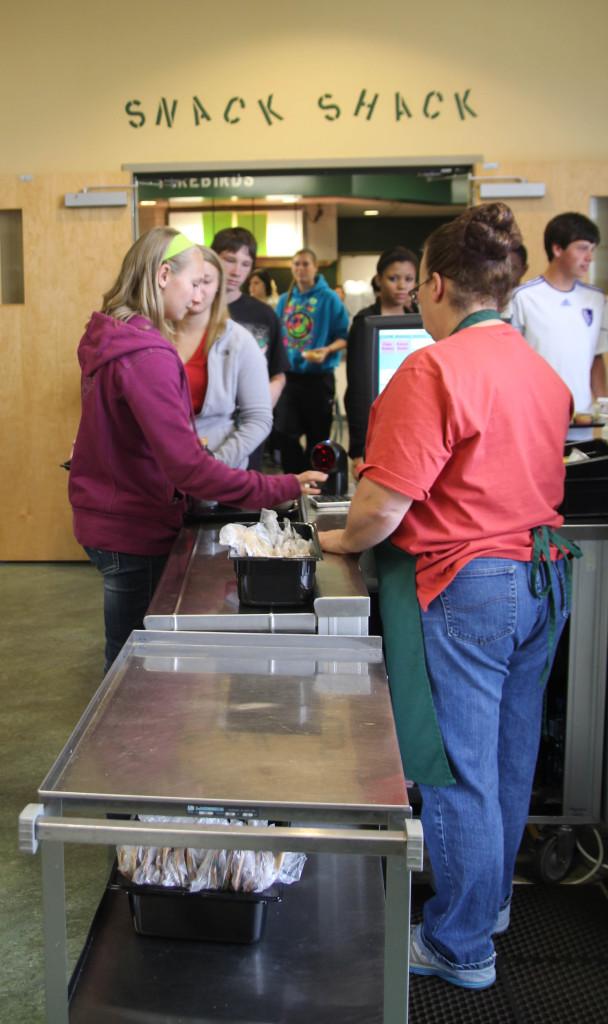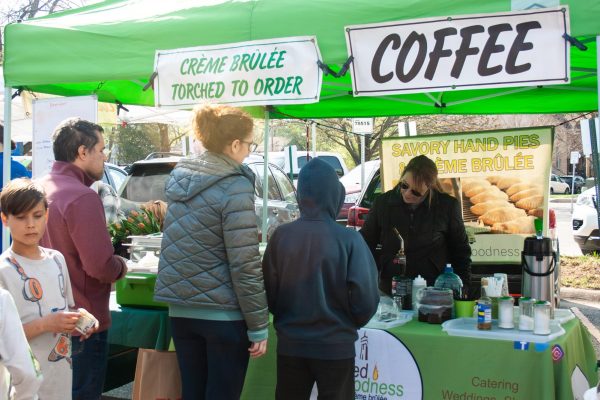Behind the Meals
school lunch myth debunked from cafeteria to commons
On a daily basis, the cafeteria workers arrive at 6:30 a.m. to satisfy the breakfast crowd with huge grins, open arms and ample pumpkin muffins.
After 8:05 a.m., the lunchroom still hasn’t taken any breaks. Cafeteria workers spend a portion of the morning stocking several vans with pizza, egg rolls and salads. These vehicles then head off to cater to schools all around the district–even sometimes the district office. Then, after the catering is complete, the cafeteria staff gears up for the winding lunch lines that will begin assembling at 11:47 a.m.
The cafeteria serves around 800 students daily, except for on chicken strip days, when they serve 900 students. Another popular item is the tri-taters. The cafeteria works through approximately 180 pounds of the fried potato triangles per week.
Despite these crowd favorites, not everything is ideal in the lunchroom. Sandy Barnes, the main dish cook, would like to spice things up a bit, or, at the very least, season the vegetables. But one thing is holding her back from achieving that goal: the government.
The government ensures that the cafeteria food is healthy and beneficial for the students, and the workers must get the menus approved before they change anything .
Kathy Hanna, cafeteria manager of 16 years, didn’t complain when the government stepped in to make school lunch more healthy; she accepted it and made sure her kitchen implemented these changes.
“We have begun to use less frozen items and canned soups because of their high sodium content,” Hanna said.
As a replacement, the staff began to make homemade soups. They also had to reduce the use of sugar. To accommodate that, they offer many kinds of fresh fruit on the salad bar. The big bowl of fruit has to be refilled during every lunch block.
Some students who would like to choose nutritious meals feel limited by the cold, vegetable-based options and are turned off by the long lines to get a sandwich.The cafeteria could work on providing healthier choices that are still “hot lunches.”
Junior Tommy Finch said he would choose nutritional foods if there were any choices beyond salads and sandwiches.
“I like something chewy and meaty for lunch,” Finch said.
Junior Tyler Darnall is not a fan of school lunch, deeming the food to be “greasy” even as it underwent a “healthy” makeover.
When asked why he didn’t purchase a salad or sandwich to avoid the greasiness, he said the healthy grub had no flavor.
“I don’t think they used to be healthy,” Darnall said, “but now they’re like grossly healthy that it’s to the point that nothing is good…”
Senior Cale Kobler has a similar view, but he takes a different approach.
“The bad-for-you options, like pizza, they try to make healthy, which makes you not want to eat it because it’s not good,” Kobler said. “So I get the healthier ones because they don’t mess with it.”
Along with government regulation of the food served, the cafeteria has other strict standards to maintain.
Food upkeep is a very serious matter in the lunchroom. The food has to remain at certain temperatures. Temperatures of the food are taken in the salad bar as well as the main dishes.
Every five years, the workers in the lunchroom have to go through sanitation training, but cleanliness isn’t the only health concern when it comes to cafeteria food.
“The produce regulations change constantly,” said Lisa Baxter the assistant manager of 16 years.
They have to meet those regulations with the produce, while keeping everything else at safe temperatures and conditions. For example, the taco meat changes pans and goes through a quick chill process to lower the temperature. To remain as safe as possible, it can only be reheated one more time.
The lunchroom staff created a motto to remind themselves of the extensive processes’ purpose.
“If I wouldn’t eat it, why would the kids eat it?” Hanna said.
Even though the staff tries to meet lunchroom regulations and the workers wear gloves and hair nets, that hasn’t stopped them from getting a few violations. As of Nov. 6, 2012, the cafeteria was issued one violation because of a small pest issue. Using the glue traps, the kitchen staff immediately got the problem under control.
When their next inspection happened on Jan, 24, 2012, the small pest issue was gone and they had no violations.
Their most recent inspection on Sept. 4, 2013 was a slight regression from their inspection in January. The violation was no longer pest control but cleanliness. By mistake, an employee touched their face with a gloved hand and continued to work afterwards without changing her gloves. Also, proper hand washing signs were supposed to be on display at each handwashing sink. Only one sign was found at one sink, while six others remained without proper signage.
However, the inspections were irregular, with three in 2012 compared to just one inspection in 2010 and 2011.
Despite these rough patches, the staff remains positive and retains a team-like bond as they rally to fix their violations.
Your donation will support the student journalists of Lawrence Free State High School. Your contribution will allow us to purchase equipment and cover our annual website hosting costs.







